ASUS N61Jv-X2: Optimus GT325M Meets Arrandale
by Jarred Walton on March 13, 2010 10:00 PM ESTASUS N61Jv-X2 Gaming Performance
The biggest selling point for the N61Jv over the competition is undoubtedly Optimus Technology. With a reasonable GPU, users get the benefit of being able to run games when they want, but they don't have to sacrifice battery life. We'll look at battery life next, but first we've got gaming results.
We used the built-in benchmarks for Batman: Arkham Asylum, Crysis: Warhead, DiRT 2, Far Cry 2, and the S.T.A.L.K.E.R.: Call of Pripyat benchmark. Empire: Total War and Mass Effect 2 used FRAPS and a repeatable segment. All of the results below are for 1366x768, since that's the native resolution on all of the laptop LCDs. We used the low/minimum (whichever was lower) setting for the default test, but we've included higher quality settings on the ASUS N61Jv. Unlike most of the other laptops in the charts, the N61Jv has enough graphics performance to handle ~Medium settings in nearly every title, and even higher settings in some games. Also note that we've dropped older Intel and AMD IGP results from the gaming charts; the former is certainly not worth the bother in games.
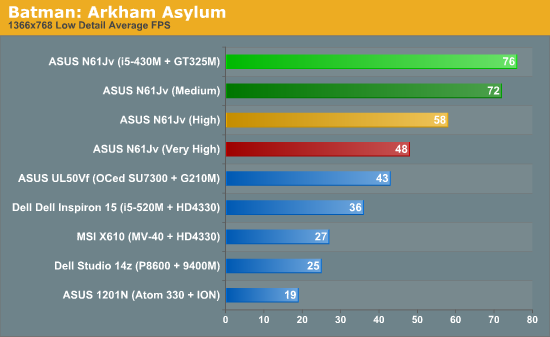

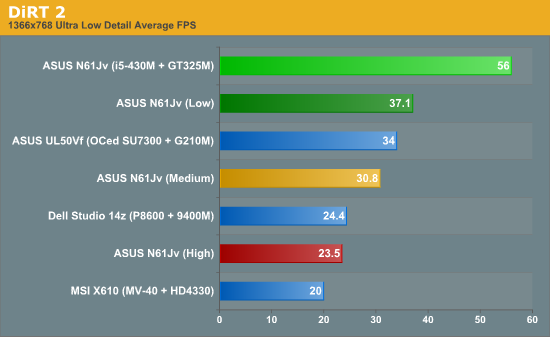
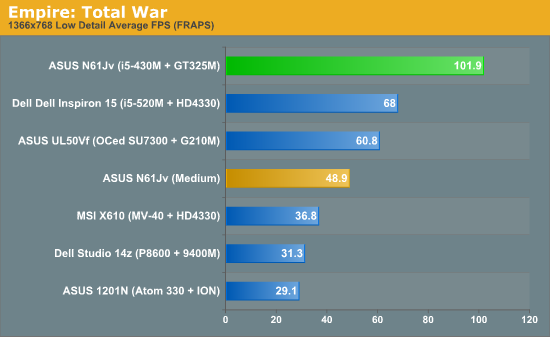
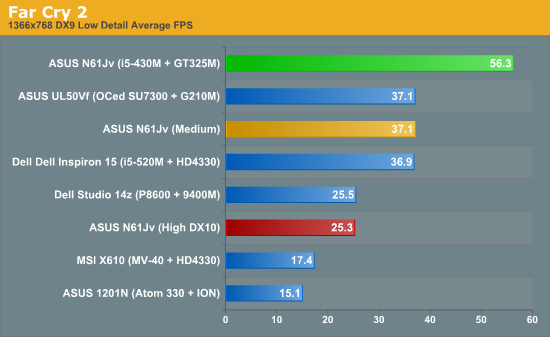
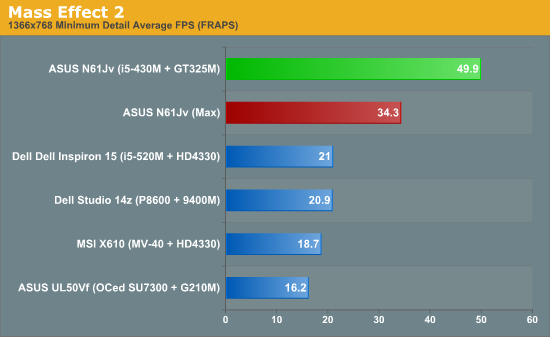
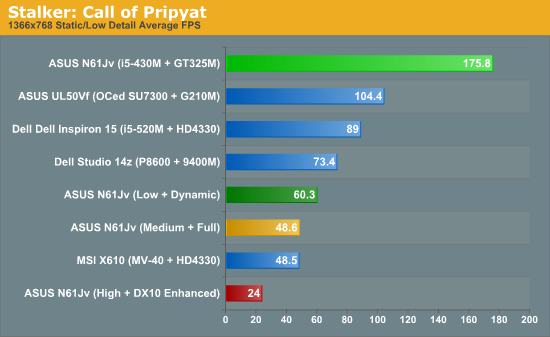
As expected, the performance advantage for the GT325M is very large compared to the other laptops in the field. The N61Jv ends up being anywhere from 50% (low detail Far Cry 2) to 250% (minimum detail Crysis: Warhead) faster than the UL50Vf. Likewise, the lead over the Inspiron 1564 (HD 4330) is 50% to over 200%. The N61Jv not only provides good gaming performance at the native 1366x768 panel resolution, but it also manages to do so with medium or higher detail settings (with the exception of Crysis: Warhead where a few settings would need to drop from "Gamer" to "Mainstream" to get performance above 30FPS). Overall, the i5-430M and GT325M is an excellent combination for an all-around computer. It won't set any speed records, but it can provide a good to excellent experience in every application we've tested.
One glitch that we did encounter with Optimus in our gaming tests is that the Steam version of Empire: Total War appears to limit our available settings based on the capabilities of the Intel HD Graphics IGP. We couldn't select the "High" or "Very High" graphics presets, and many of the individual preferences were missing the High/Very High options as well. NVIDIA is aware of the problem and we expect an updated Optimus profile will remedy the situation. As seen in the charts, however, the drop from Low to Medium is rather precipitous, and we know from experience that the High preset cuts performance by another ~third relative to Medium.
Optimus is new technology, and we expect a few hiccups with games; we also had a slight glitch with the latest Intel IGP driver, which broke Optimus support until NVIDIA and Intel were able to work together and address the problem. You'll want the updated NVIDIA Optimus driver (32-bit version here) if you plan on running with the March Intel driver. NVIDIA states that they "are working with Intel to ensure this issue does not happen again." The new NVIDIA Optimus driver includes improved merging of Optimus profiles and additional performance enhancements.
Obviously in our tests today we're comparing a more recent NVIDIA GPU against older ATI chips, and that's not entirely fair. We have an Acer 5740G laptop that we've begun testing, and we can report that it is indeed faster than the N61Jv—typically around 20% faster. The catch is that you give up not just Optimus, but switchable graphics as well. What that means is that gaming performance is better but battery life is worse. Some will also wonder about the DX11 factor; after all, HD 5650 provides it and nothing from NVIDIA can match it for now. That's true, but again we have to go back to Optimus. It's the clearly superior solution if battery life matters at all, and even though DX11 is the latest and greatest, the fact is most titles that feature DX11 support will run quite slow on the HD 5650. Just to throw out a couple examples, STALKER: Call of Pripyat with medium detail and DX11 + Tessellation yields a 1366x768 result of 33.7 FPS—playable, but not at all high performance. DiRT 2 performance drops to just over 20 FPS at high details with DX11 features enabled, making it even less palatable. We'll provide full details in our upcoming review of the Acer notebook, but the decision still comes down to performance vs. battery life.
What we'd really like—and what we're unlikely to see for a while yet—is Optimus Technology paired with a DX11 capable GPU. Alternately, getting an AMD equivalent of Optimus would be acceptable as well. Sadly, both options are more than likely several months away at best, and there are rumblings that NVIDIA may not have any mobile DX11 parts until the next cycle. When DX10 parts first arrived, we were in a similar situation for over a year, and we could very well experience a relapse with the NVIDIA DX11 rollout. Given the choice between DX10 + Optimus and DX11 without Optimus, for a midrange laptop we'd rather have Optimus. Like DX9 and DX10 before it, we expect DX11 to remain a high-end feature in games for a while. When DX11 games run acceptably on midrange mobile GPUs, NVIDIA and AMD will both be using something other than their current parts.










44 Comments
View All Comments
avilella - Monday, March 22, 2010 - link
We are looking for students with basic Linux kernel/graphics notions interested in applying for the X.org Open Source PRIME multi-gpu support Google Summer of Code 2010:http://wiki.x.org/wiki/SummerOfCodeIdeas">http://wiki.x.org/wiki/SummerOfCodeIdeas
We are also looking for Linux users with Nvidia Optimus-enabled laptops willing to provide debugging information for Open Source PRIME multi-gpu support features being worked on. Please join the team by clicking on "Join" on the right, fill in this doodle:
http://www.doodle.com/63fyczzrxqaquhqx">http://www.doodle.com/63fyczzrxqaquhqx
and send an email to the mailing list specifying your laptop model with these commands:
sudo dmidecode -s system-product-name
sudo dmidecode -s system-version
lspci -vnnn | perl -lne 'print if /^\d+\:.+(\[\S+\:\S+\])/' | grep VGA
utkal - Monday, March 15, 2010 - link
I do not understand why the hell Asus only hosts 1366x768 resolution lcds in their laptops. They have ONLY ONE laptop of full HD upto 16" screen size with a price of $1440 (approx) ! wtf ! In a 16" laptop what can be worst than this resolution lcd.Sorry, but how AT reviewer said, we did not found anything bad about this laptop ? funny ! Do not you know the 1366x768 resolution makes the life hell if you use the laptop for work. Yes, if the laptop is bought ONLY TO GAME then its ok.
JarredWalton - Saturday, March 20, 2010 - link
RTFA. From the conclusion:"The worst aspect is the mediocre LCD panel, but when everyone uses lousy LCD panels (at least in sub-$1000 laptops and notebooks), we can only complain so much. The LCD panel and somewhat small battery capacity prevent us from giving the N61Jv our top Gold award...."
I've looked at dozens of laptops, and I've got a bunch more I'm working on reviewing. The ASUS Eee PC 1001P and the ASUS G73J are the ONLY laptops I have right now that don't have a similarly lousy LCD. Sure, you can get high-end laptops with good LCDs (Dell Precision M6500), but for consumer notebooks it's a lot harder than it should be.
jackwhitter - Monday, March 15, 2010 - link
"Today, we're reviewing our second Optimus notebook, but while the chassis isn't any smaller—in fact, it's slightly larger with a 16.0" LCD"it has a larger monitor with the same low resolution as a 11" monitor. why are companies so insistent to use such a low resolution on these larger screens? what happened to 1600x900?
JarredWalton - Monday, March 15, 2010 - link
One factor is cost and another is gaming performance. The GT325M will run most games at 1366x768 with Medium/High details at good frame rates. If the native LCD moved up to 1600x900, gaming performance would drop 37%. But the bigger issue is cost, I'm sure.utkal - Monday, March 15, 2010 - link
Dear, At least I do not think that people buys a laptop ONLY TO GAME. The primary purpose of laptop should not be gaming. And If you will work with applications like visual studio, you can hardly see few lines of code with a 1366x768 resolution where the vertical resolution will taken up by application titlebar, menubar, various toolbars, status bar and finally OS's taskbar !!! Now understand how difficult it to work with such low resolution laptop.No doubt other components are excellent with this price range, but they MUST have option for higher resolution screen, instead of making laptops for only GAMERS.
erple2 - Monday, March 15, 2010 - link
I'm sure that the only issue is cost. Many people will look at this computer at 900 dollars compared with 1200 for the one with higher resolution LCD and commensurate faster GPU and just buy the 900 dollar one.I would be more than happy to spend an additional fee for a better screen and faster discrete GPU (200-300 is about what I'd pay, I think, unless the GPU was _significantly_ faster, and/or the screen was _significantly_ higher quality/resolution).
jasperjones - Monday, March 15, 2010 - link
I refuse to buy products that don't have full Linux support. Linux support is much more important to me than a 10-15% difference in battery life.What happens if you try to install a recent Linux distro such as Ubuntu 9.10 on an Optimus laptop? Unfortunately, a quick Google search didn't provide any insights. (Btw, one of the top hits of my search was the launch article on Optimus here on Anandtech. There, Jarred asked virtually the same question.)
GeorgeH - Monday, March 15, 2010 - link
AFAIK an Optimus laptop should be considered a Win7 exclusive device, but confirmation would be nice; hopefully JW comes through.Quote from JW Feb 9:
"Some of you asked about Linux support ... at present, NVIDIA is focusing on Win7 ... we're not even sure what would happen if you try to install Linux ... we're going to quickly check and post the results."
http://www.anandtech.com/mobile/showdoc.aspx?i=373...">http://www.anandtech.com/mobile/showdoc.aspx?i=373...
Either we missed the promised update or our definitions of "quickly" are a little different. ;)
JarredWalton - Monday, March 15, 2010 - link
I did actually try Linux on the UL50Vf, but I neglected updating the article. Here's what I just put in there:I did actually test what happens with Optimus laptops and Linux. Even using an older 9.04 installation of Ubuntu, everything works as expected... which is to say, you can run Linux but you won't get the Optimus GPU. Since there's no direct connection of any display to the GPU, Optimus is required to move rendered content from the G210M to the GMA 4500MHD display buffer. As noted above, NVIDIA is currently focusing their efforts on making Optimus work on Windows 7; it's possible they will move to other OSes down the road, but they are not committed to doing so. If you want to run Linux and you want to use a discrete GPU, Optimus Technology won't work. Perhaps some skilled Linux community folks can figure out a way to do Optimus-like technology on their own, but given the level of detail required to interface with the GPU and IGP we see that as unlikely.
If you're one of the few people that want to run Linux and use a discrete GPU, then Optimus is definitely not going to make you happy. If all you want is to dual-boot Linux and you're okay with running it off the Intel IGP, you'll be fine.